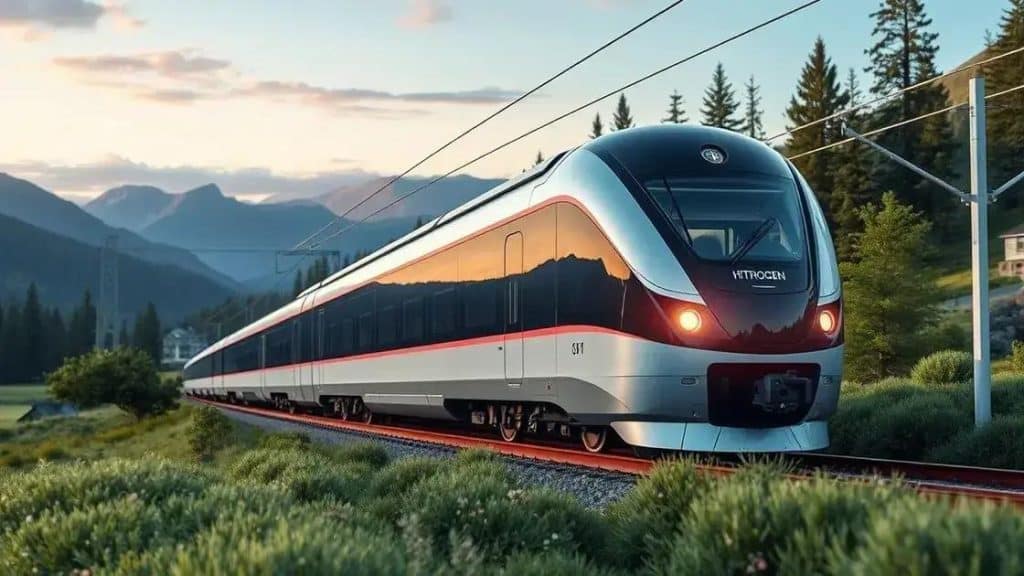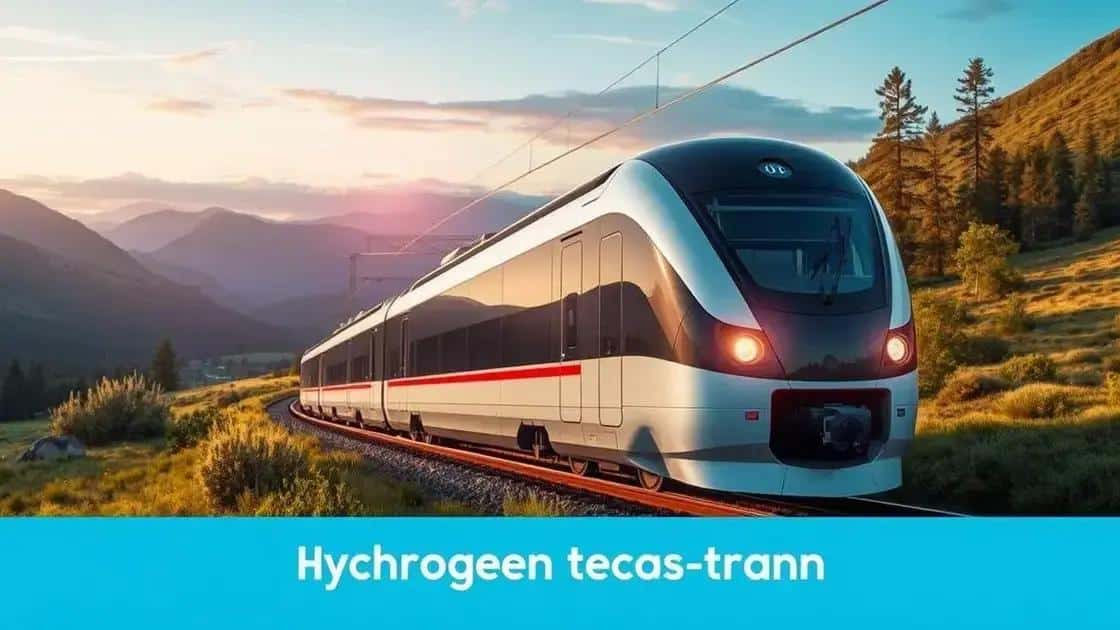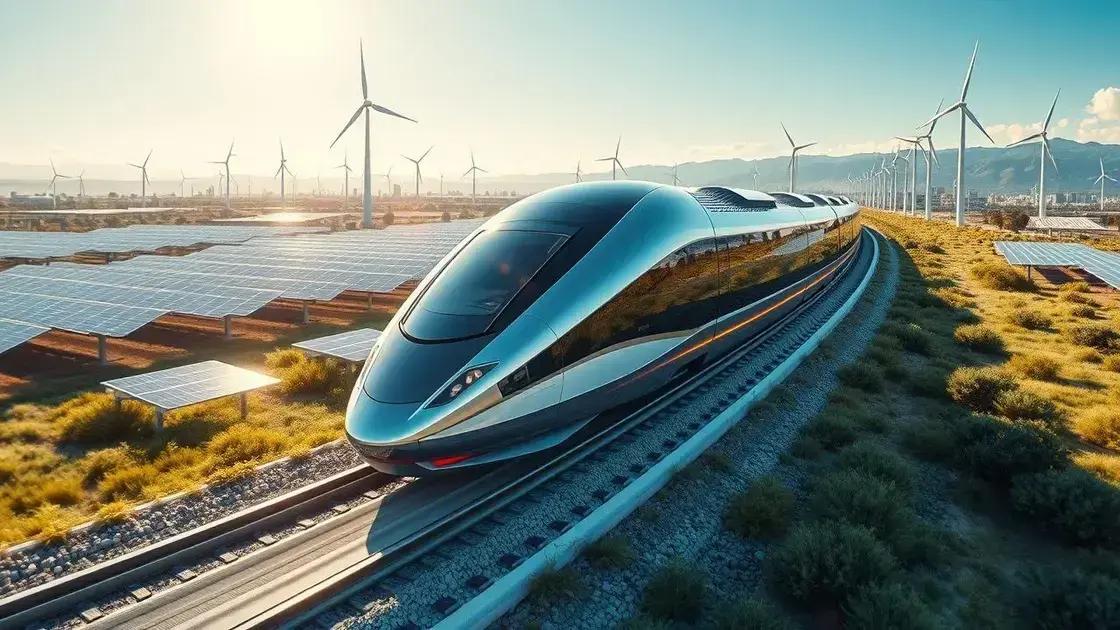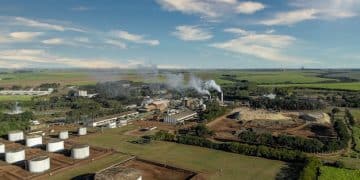Hydrogen-powered train technology developments reinvent travel

Hydrogen-powered train technology offers a sustainable alternative to traditional trains, featuring zero emissions by using hydrogen fuel cells, improved air quality, and greater operational flexibility on non-electrified tracks.
Hydrogen-powered train technology developments are changing the landscape of public transportation. Have you considered how these advancements could reshape our travel experiences? Let’s dive into this topic and explore what’s happening.
Current advancements in hydrogen-powered trains
Recent advances in hydrogen-powered trains are making headlines around the world. As the transportation industry seeks more sustainable solutions, these innovations promise to reduce carbon footprints significantly.
One of the key developments in this area is the introduction of fuel-cell technology. Fuel cells convert hydrogen and oxygen into electricity, powering trains without producing harmful emissions. This technology not only offers a cleaner alternative but also enhances efficiency.
Key Features of Modern Hydrogen Trains
Today’s hydrogen-powered trains come equipped with several impressive features:
- Low noise levels compared to diesel engines.
- Ability to travel long distances on just one tank of hydrogen.
- Reduced maintenance costs due to fewer moving parts.
- Potential for quick refueling times, similar to conventional trains.
Moreover, numerous rail networks are testing these trains in real-world conditions. For instance, countries like Germany and the UK have already introduced hydrogen trains into their fleets, showcasing their effectiveness and reliability.
Benefits for the Environment
Switching to hydrogen-powered trains can lead to significant environmental benefits. By replacing diesel trains, we can expect:
- Lower greenhouse gas emissions.
- Improved air quality in urban areas.
- Less dependency on fossil fuels.
As research continues, advancements in hydrogen production and storage will further enhance the viability of these trains. Innovations in electrolysis technology, which splits water into hydrogen and oxygen using renewable energy sources, could lead to even more sustainable practices in the future.
These developments present a promising future for rail travel, paving the way for a more environmentally friendly and efficient mode of transportation. The journey towards a greener transportation system is well underway, and hydrogen-powered trains are at the forefront of this evolution.
Impact of hydrogen trains on the environment

The impact of hydrogen trains on the environment is profound and largely positive. These trains are designed to reduce the overall carbon emissions typically associated with diesel-powered locomotives, making them a cleaner choice for transportation.
By using hydrogen fuel cells, these trains emit only water vapor, contributing to better air quality. This efficiency helps mitigate climate change by decreasing greenhouse gas emissions from the transportation sector.
Benefits of Hydrogen Trains for Air Quality
One of the most significant benefits of hydrogen-powered trains is their potential to improve air quality in urban areas. Here are key advantages:
- Reduction of harmful nitrogen oxides and particulates.
- Decreased noise pollution compared to traditional diesel trains.
- Improved health outcomes for communities near rail lines.
As cities battle pollution, adopting hydrogen trains can significantly lower air contaminants that harm public health. Additionally, these trains promote a greener image of public transport.
Long-term Environmental Impacts
The long-term benefits of switching to hydrogen trains extend beyond immediate air quality improvements. The use of renewable energy sources to create hydrogen, such as wind or solar power, can further enhance sustainability. This means that the entire fuel cycle, from generation to consumption, can be environmentally friendly.
Moreover, investing in hydrogen technology encourages research and development in clean energy solutions. This investment not only helps the train industry but also supports broader efforts to move toward a sustainable energy future.
Overall, the environmental impact of hydrogen trains highlights their potential to transform the rail industry and contribute to a more sustainable world. As these advancements continue, they represent a hopeful shift toward eco-friendly transportation solutions.
Comparative analysis of hydrogen and electric trains
A comparative analysis of hydrogen trains and electric trains reveals interesting insights into their respective advantages and challenges. Each option plays a role in moving toward sustainable transportation, but they do so in different ways.
Hydrogen trains utilize fuel-cell technology, converting hydrogen gas into electricity. This process emits only water vapor, making them environmentally friendly. In contrast, electric trains run on electricity supplied through overhead lines or electrified tracks, which can also be generated from renewable sources.
Key Differences Between Hydrogen and Electric Trains
When analyzing both types of trains, several factors come into play:
- Fuel Source: Hydrogen trains rely on hydrogen as fuel, while electric trains need a constant electricity supply.
- Infrastructure: Hydrogen trains can operate on tracks without electrification, allowing for more flexibility in rural areas.
- Range: Hydrogen trains generally have a longer range compared to electric trains, which may be limited by available charging stations.
- Refueling versus Recharging: Hydrogen trains can be refueled quickly, similar to conventional trains, whereas electric trains often require longer charging times.
This comparison illustrates how both train types contribute to reducing carbon emissions, yet they cater to different operational needs. Electric trains are ideal for routes with existing electrified tracks, which ensures efficient energy use.
On the other hand, hydrogen trains present a promising solution for regions that lack infrastructure. They can serve as a bridge in transitioning to cleaner transport options while new electric rail lines are developed. Both technologies are vital as we move forward in enhancing sustainable rail transportation.
By understanding the strengths and weaknesses of hydrogen and electric trains, we can better appreciate their roles in shaping the future of public transport. Each has its place in the journey toward an eco-friendly transportation network, highlighting an exciting time in rail innovation.
Future prospects for hydrogen train technology

The future prospects for hydrogen train technology look promising as the world increasingly seeks sustainable transportation solutions. Continued investment in this field is essential to overcoming current challenges and unlocking its full potential.
Research and development are focused on improving hydrogen production methods, aiming for more cost-effective and eco-friendly options. Innovations such as using renewable energy sources to generate hydrogen are gaining traction. By pairing these technologies, we can create a cleaner supply chain.
Innovations in Hydrogen Technology
New advancements are being made in various aspects of hydrogen technology, which can significantly impact train systems:
- Enhanced fuel cell efficiency to maximize energy output.
- Improved hydrogen storage solutions to increase range and safety.
- Development of refueling infrastructure compatible with existing networks.
- Investments in public-private partnerships to accelerate innovation.
As countries strive for zero-emissions goals, hydrogen trains are becoming more appealing. The ongoing transition towards greener public transport presents an opportunity for this technology to thrive.
Global Adoption Trends
Many nations are exploring the integration of hydrogen trains into their rail networks. Countries like Germany, the UK, and Japan are at the forefront, piloting successful projects that demonstrate viability. As these programs expand, they may serve as models for others to follow.
In the coming years, we may see more collaborations across borders, bringing together expertise and resources. This collaborative spirit can lead to shared best practices and accelerate technological advancements.
In summary, the future of hydrogen train technology is full of potential, with a focus on sustainability and innovation. As research progresses and more countries embrace this technology, it could play a crucial role in transforming global transportation systems for the better.
FAQ – Frequently Asked Questions about Hydrogen Train Technology
What are hydrogen trains?
Hydrogen trains use hydrogen fuel cells to generate electricity, emitting only water vapor and significantly reducing emissions.
How do hydrogen trains impact the environment?
They contribute to cleaner air by reducing harmful emissions compared to traditional diesel trains, leading to improved public health.
What are the advantages of hydrogen trains over electric trains?
Hydrogen trains can operate on non-electrified tracks, have quicker refueling times, and often boast longer ranges than electric trains.
What is the future of hydrogen train technology?
The future looks bright, with ongoing innovations in hydrogen production and increasing global interest in adopting this sustainable technology.





